
The Atlantic Ocean heaves around Here and Now, a racing sloop that carried The Globe and Mail's Ian Brown from Baddeck, N.S., to the coast of Maine, its owner's home state.Ian Brown/The Globe and Mail
On the ocean, on a clear day, the horizon is five kilometres away. The edge of the world looks more distant on the endless sea, but never is.
Here and Now was three times that far out on the Atlantic Ocean southeast of Cape Breton, lurching toward Maine at seven knots an hour, when the surface of the sea began to resemble multiple pairs of heaving lungs. The day before, the swells were disciplined ranks marching in line up from the south, platoons of chiselled four-foot hull-bangers you’d expect while sailing directly into the breeze 569 nautical miles across the Gulf of Maine, from the village of Baddeck, Alexander Graham Bell’s old home in Cape Breton, to Mount Desert Island.
But suddenly, the ocean seemed to be moving not so much in any direction as breathing in and out, which is to say up and down, in patches of gunboat grey. Unlike the rest of the wind-ridged ocean, the patches were glassy, like huge squares on a quilt, except that they were, as I mentioned, heaving up and then down and then up and then down, each at its own pace. It was not a pleasant sensation.
“It’s the tide affecting the current,” the captain said. “If the tide starts moving in the same direction and at the same speed as the wind, the waves disappear, and you can get those glassy patches.”
The captain owned Here and Now, a thirty-eight-foot Concordia racing sloop adapted to motor sailing, which is what it’s called when you keep the sails up and the motor going and run 30 per cent off the wind, instead of wasting time by tacking more obliquely back and forth across it. The boat was originally christened Leda, after the swan. “I didn’t think it was a good idea to be sailing a boat named after a rape victim in a crime that also entailed bestiality,” the captain allowed. He intended this as a joke.
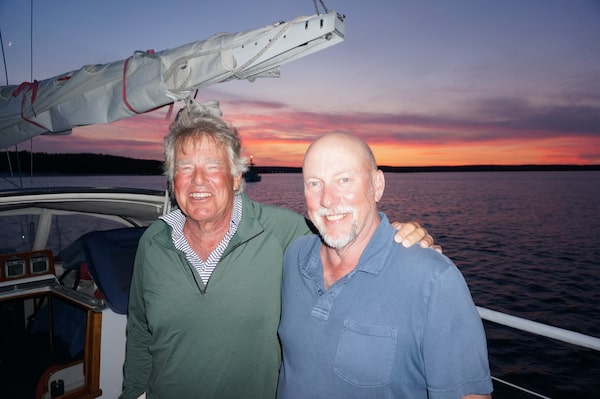
Here and Now belongs to Sandy Andrews, left, with younger brother Laurie.Ian Brown/The Globe and Mail
The captain – his real name was Sandy Andrews – was 69, a deeply experienced sailor and former institutional banker in Boston who had hated his job enough to retire at 50. He was widely read, well off, formidably intelligent and Republican, which made the three of us, politically, a full spectrum boat. He’d been cruising the shores of Labrador and Newfoundland for a month and now needed someone to help him grunt the boat back to his home in Maine.
So when his younger brother Laurie, an old Los Angeles pal I hadn’t seen in twenty years, called and asked if I wanted to join them, I said, of course. I had never sailed overnight on the open ocean in a sailboat, never mind for 10 days. And this was the Atlantic Ocean: my favourite body of water, the second largest of the earth’s seven seas, covering a fifth of the globe; the brisk, frigid, once-fishier realm my father sailed and fought and lost a brother on, near which I had spent most of the summers of my childhood. The Atlantic was water I felt in my deep being, water I wanted to get to know better. Not to mention the central engine of the world’s thermo-aqueous heating and cooling system, and therefore one of the main engines of the Western Hemisphere’s climate, and – thanks in large part to so-called human progress – now an increasingly unreliable engine at that. Hurricane Fiona caused $680-million in insured damages in September; its economic cost could reach $4-billion. It was high time to know the Atlantic more intimately, to find out if being on it could shed any light on climatological turmoil and biological collapse occurring within its depths. I imagined a luxurious, rollicking, sun-drenched voyage that would alert me to the perils of climate change but reassure me of the ocean’s vast long-term ability to absorb man’s insatiable ambitions. I was wrong on all counts. Call me Ishmael.
Ian Brown – shown in Lunenburg, N.S., on July 30, before the departure for Maine – had never sailed overnight on the open ocean before this trip.Ted Pritchard
About 200 million years ago, the last known supercontinent on earth, a giant loaf of land centred on the equator and known today as Pangea, began to push and pull apart, thanks to shifting tectonic plates and hot magma pluming up from the molten core of the earth. The first cracks may have appeared near what is now Iceland.
Up to that point Pangea was surrounded by a superocean we call the Panthalassa Sea. Paleogeographers think the Panthalassa flooded into Pangea’s widening cracks to form the North Atlantic. The whole process took more than 50 million years. The South Atlantic came to be 150 million years later, which is why the Atlantic is sometimes known as the youngest ocean. But even the Atlantic has been around a long time. We have not.
Atlantic currents drive the climate of eastern North America and Europe, the so-called thermohaline conveyor belt that exchanges warm surface water for cold, dense, nutrient-rich bottom water, and vice versa.
In the North Atlantic, the water’s cold. It’s fed by (among other sources) the Greenland Sea and the glaciers and rivers of Labrador and the Arctic, where cold water sinks to depths of 3,000 metres at a rate of 10 centimetres per second. All that dense cold water sinks and joins a huge pool known as the North Atlantic Deep Water.
The Deep Water forces cold water down and south toward Antarctica, in a slow-moving current. That ooze joins the eastward-flowing Antarctic circumpolar current, where it chills even more until part of it peels off northward through the Indian Ocean and up the eastern side of the Pacific. There it mixes with warmer water and starts to rise. Nutrients come to the surface. The warming current then flips south again, past China and Indonesia and the southern tip of Africa, and eventually reappears in the south Atlantic. The now warm water merges with the Gulf Stream (80 kilometres wide, a kilometre deep), which goes on to warm and moderate the climates of Britain and Europe before rejoining the North Atlantic Deep Water again, for re-cooling. According to the National Oceanic and Atmospheric Service, a complete cycle and changeover of Earth’s ocean water takes – are you ready for this? – anywhere from 500 to a thousand years. In other words, it may take so long for aberrations in the cycle to appear that, by the time they do, they’re serious problems.
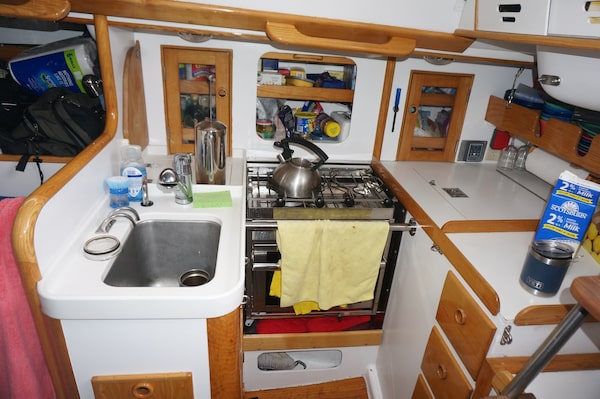
Here and Now's kitchen. After one breakfast early in the voyage, the sailors would go over the procedures for what to do if one of them fell overboard, or if they had to abandon ship.Ian Brown/The Globe and Mail
Capt. Sandy liked to sail for eight to 10 hours a day. He was distracted and curt in the mornings, as we set out again across the unpredictable sea, and didn’t relax until we dropped anchor in the late afternoon, when everyone was safe again. Captains tend to be yearning types: on land, they can’t wait to get to sea; at sea, they can’t wait to get to land. They speak to the rattling restlessness in all of us.
We had just finished breakfast (scrambled eggs) on Day 2 when he laid out the procedures to be followed in the case of two emergencies. “The first is man overboard,” he said. We were tethered by safety straps to guylines on the bouncing, heeling boat, but if you went over and found yourself being pulled under, you had to disengage. Meanwhile, your shipmates were to a) shout “Man overboard!”; b) toss you a floating cushion; c) mark your location on the electronic chart; d) pull the release handle on an auto-inflating beacon-equipped floating ring; e) stop the boat and swing about; and f) figure out how to haul your sodden bulk three metres out of the water back onto the deck. Sandy figured the routine would take half an hour. Half an hour is a long time in the Atlantic.
And if you fell overboard on your watch at night while your companions were asleep? The captain forbade us to leave the cockpit even to pee without waking someone up. The prospect of it happening anyway was a steady worry.
“The other command you need to know,” the captain continued, “is abandon ship.” He then described an even more rococo routine that involved survival suits and a life raft. It sounded preferable to falling overboard at night.
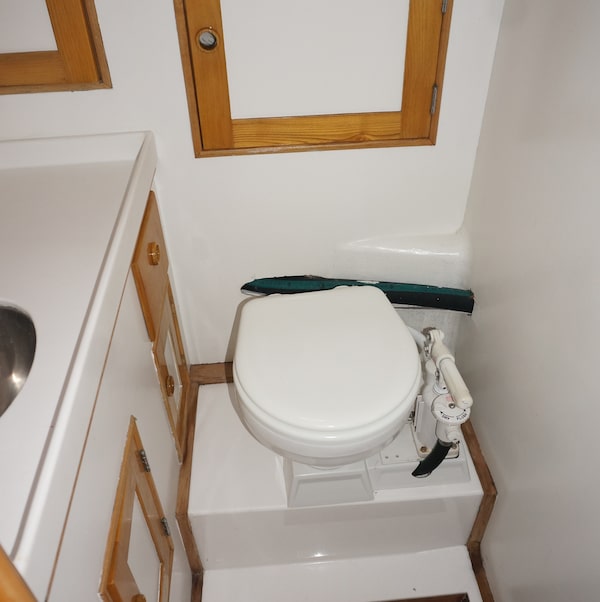
The toilet, or 'head,' turned out to be more of a headache for The Globe's correspondent.Ian Brown/The Globe and Mail
By our third day out of Baddeck, as we headed through St. Peter’s Canal toward the open ocean, my nervousness about throwing up – common to many first-time sailors – was matched only by my anxiety about using the head, the on-board hand-pumped vacuum toilet.
Capt. Sandy did not condone the use of said head, because it was delicate and prone to malfunction and thus clogging and stinking. “If you break it,” the captain commanded, “you fix it.” The alternative was evacuating downcurrent while treading water or hanging off the stern of Here and Now, an act of bodily dissociation I will not describe in detail in a family newspaper.
And I haven’t even mentioned the challenge of trying to pull one’s foul weather gear and pants and long underwear down while standing up on a tiny platform in the hold of a wildly pitching sailboat and then finding and descending onto the tiny seat ring of the vacu-bog. It was like bouncing naked on a pogo stick and then letting go mid-air and somehow landing backwards on a dancing doughnut.
“So,” I said to my captain on our fourth day at sea, after lying on my back all morning trying not to vomit, “what is the point of cruising?”
“It should take you away from the rest of the world, so your world becomes this little spot,” he replied, without hesitation. “It gets you in the moment.”
Which is possibly true. It’s just that our present moment happens to be an especially alarming one, especially at sea.
Glen Gawarkiewicz talks about his research at the Woods Hole Oceanographic Institution in Massachusetts. The researchers' array of undersea buoys helps them to track changes in Atlantic temperatures, salinity and more.Jodi Hilton/The Globe and Mail
If you take a small plane from the Bar Harbor Airport, where Martha Stewart and her ilk park their private planes with velvet dust covers protecting the jet engines, and make your way to the Woods Hole Oceanographic Institution in the armpit of Cape Cod, you can meet people who are trying to make the Atlantic Ocean less of a mystery. But for every flash of clarity there is an accompanying shadow of alarm.
Glen Gawarkiewicz, a senior oceanographer at Woods Hole, has been studying the Atlantic for 40 years. One of his specialties is “warm core rings,” pinched-off blobs or eddies of the Gulf Stream that migrate, often at depths you would not expect to find warm water, into the much colder waters of the coastal shelf of eastern North America. The rings have an average diameter of 100 kilometres, roughly the distance from Toronto to Georgian Bay.
According to a study Dr. Gawarkiewicz and some colleagues published in 2019, the number of rogue warm core rings doubled between 2000 and 2018; they now intrude all the way along the continental shelf break from Cape Hatteras to the Grand Banks. They create changes, Gawarkiewicz et al. contend, in “circulation and water masses, ecosystem response, fisheries abundance, fish recruitment and seasonal migration.” They are partially responsible for the fact that between 2003 and 2018, the northwest Atlantic warmed three times faster than it had in the previous 125 years.
A visit to Woods Hole makes you understand how hard it is to gather undersea data. The campus is littered with stacks of giant buoys and racks of cables and sensors, many of which are part of the institution’s ocean observatory initiative. The Pioneer Array, for instance, is a network of buoys anchored to the sea floor in a rectangle 10 kms wide and 50 kms long, at the top of the continental slope off the eastern shore of the United States. Sinking and rising sensors move up and down the mooring lines to measure temperature and current and salinity and a host of other factors from the surface to the bottom of the ocean. Meanwhile, fleets of gliders and self-guiding, torpedo-like probes travel around the array, sending data back via satellite.
All this intelligence comes back in real time to a darkened command centre at the Institute. “NASA has their big room, with all those people in white shirts that are always very well starched, unlike oceanographers,” Dr. Gawarkiewicz explains. “This is the oceanographic equivalent right here. This is real-time data from observatories at seven mooring sites.” He is clearly thrilled to be there, surrounded by feeds from underwater cameras and screens of ever-changing data.
Amy Bower, one of Dr. Gawarkiewicz’s colleagues, is leading an effort to install another string of moored floating sensors, complete with drifters, from Labrador to Scotland. That’s a long stretch of ocean. She hopes to measure cold- and warm-water flows in and out of the Arctic. Another necklace of sensing buoys across the Straits of Florida will track the loop current, a big feeder for both the Gulf Stream and hurricanes. Much of the money to create these new ocean-bound DEW lines derives from penalties paid out by BP after the Deepwater Horizon catastrophe.
:format(jpeg)/cloudfront-us-east-1.images.arcpublishing.com/tgam/DM3P2MYZBRBTTBHOSF7MGSE5T4.JPG)
:format(jpeg)/cloudfront-us-east-1.images.arcpublishing.com/tgam/H622PUREUJG37D6VW7UQ27L7AA.jpg)
The cabin was tight for three grown men. Capt. Sandy had the spacious forward cabin, while brother Laurie had the quarter berth aft. I was assigned the pilot berth amidships, a settee by day, the boat’s equivalent of a pull-out couch. The banquette next to my berth converted into a dining table, which in turn converted into the silverware drawer. Everything doubled as something else. The best place to lie down and think without being sick was the lee bench (harder to fall off) in the outdoor cockpit: you could look up at the clouds and think about your children. That was pleasant. The autopilot corrected the boat’s course every few seconds. Each time it did, the tiller gave a little existential shriek.
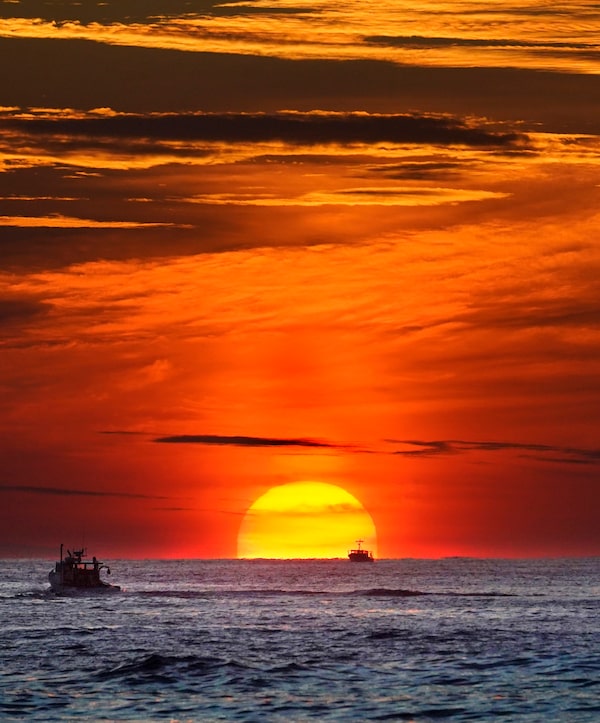
Lobster fishers work at sunrise off Kennebunkport, Maine, earlier this fall.Robert F. Bukaty/The Associated Press
Drs. Gawarkiewicz and Bower have no doubt that the Atlantic is getting warmer, thus stalling the heating and cooling of the ocean, altering the whereabouts of fish, and strengthening hurricanes. The Arctic is warming four times faster than the rest of the globe, which is changing the makeup of the North Atlantic Deep Cold water.
Another change affecting the ocean are marine heatwaves (like the heatwaves that plagued the world this summer, but in the ocean). They seem to be caused in part by northward meanders in the jetstream. In 1900, there were 30 such marine heatwave days a year. Today, there are 70. A recent Woods Hole seminar suggested the number could be 370 by the end of the century. That will be a permanent marine crisis.
On the water, of course, you understand that the crisis is already underway, a calamity that can no longer be fixed, merely endured. Up until now, the chilly Labrador current and other arms of the Deep Cold pool have pushed the warm water that feeds hurricanes out into the middle of the ocean: as a result, Maritime Canada avoids most hurricanes spinning up from the Gulf of Mexico. But the Cold Pool is warming, and the Gulf Stream is interfering with the Labrador current (partly via warm core rings), two of many reasons why Fiona was the strongest hurricane to hit Nova Scotia in decades.
“Fiona went right over a giant meander that was about to break off from the Gulf Stream,” Dr. Gawarkiewicz points out. In the week preceding Fiona’s arrival last month, the water off Nova Scotia’s Sable Island was 10 degrees hotter than it normally is. The surface temperature in the North Atlantic usually hovers around 20 to 22 degrees. If it goes above 26 degrees, the heat in the ocean will pass into a hurricane above it, stalling and strengthening the storm. Three weeks before Fiona boiled up, the Pioneer array was reporting temperatures of 25.59 C, at a depth of seven metres.
Dr. Gawarkiewicz is concerned these aberrations are on the threshold of becoming permanent within the next three to 10 years. Dr. Bower hopes to use her real-time array readings to better prepare for the consequences. “Where exactly those eddies are located when a hurricane is coming through will influence the development and path of that hurricane,” she says. And if the data warn an oil company to stop drilling before a strong loop current barrels up against a rig, it will at least mitigate some of the environmental damage caused by our nonstop reliance on oil.

Here and Now enjoys some of its more pleasant sailing weather.Ian Brown/The Globe and Mail
Of course, when the seas were calm and sunny and the winds were brisk, we were unassailable and the trip felt perfect. It was easy to forget the calamity taking place in the ocean beneath us. We made our way in 60-to-100-mile daily jumps from Cape Breton across Chedabucto Bay, past Canso (it looked bucolic and green below the lighthouse but smelled like a fish factory); down Andrew Passage into the diverticula of Nova Scotia’s stunning eastern shore, where some local lads gave us six live lobster out of a family trap that held 35 (the lobster are moving north from Maine, to find colder water in Nova Scotia and Newfoundland); past the endless string of dots that commemorate the Nova Scotian coast (Port Bickerton and Bald Island and Drunken Dick and Cuckold Island and Little Old Man and Marvins Island and Martins Point and Cherry Hill, to cite a handful). Canada has a quarter of a million kilometres of coastline, more than any other country in the world; 12,000 of them belong to Nova Scotia. That was a number to be proud of until rising seas and more frequent and ferocious hurricanes made it a more daunting number to defend.
We anchored in the late afternoons in stunning bays like Shelter Cove, deep inside Pope’s Harbour. The only place we went ashore was Lunenburg, where we docked for the night and used a real toilet and had a shower and shaved and became human again and marvelled at land-lubbing civilization. I began to understand why Melville wrote Moby-Dick the manic way he did: the ocean makes you crazy, makes you the centre of attention but removes any control you have over what happens to you, which is pretty much the way we all live these days.
Our last leg took us outside Cape Sable and across the sweeping Bay of Fundy to Maine – a 26-hour stretch, not a pleasant sail, through the fog-clogged night in three-hour shifts. You could see no further than 15 metres in any direction, maybe. I had the 3 a.m.-to-6 a.m. watch, the one with the lightning storm that showed up as a hemorrhage of red on the radar. “Don’t worry,” Capt. Sandy called out to me on the deck above as he fell asleep below, “the lightning passes through the mast into the water.”
It was as Melville wrote: “Our course was provisional, circumstantial, and not down in any map; true places never are.”
This is the strange thing: I’m not sure I would do it again, but I was thrilled to be there, eager to take it on and see it through, for the challenge rather than the pleasure. If only it were possible to face the daunting climatological future in the same frame of mind.
People fish in Fallmouth, Mass., near the Woods Hole institute. Conversations between the researchers and New England's fishing community have been a benefit to both.Jodi Hilton/Globe and Mail
'The fishermen who follow the science catch more fish,' Dr. Gawarkiewicz says.Jodi Hilton/Globe and Mail
At first, New England’s fishermen were wary of the Woods Hole scientists and their plans for the Pioneer Array. Negotiations between the two factions were intense and prolonged. But after the last public meeting held on the subject, two fishermen approached Dr. Gawarkiewicz. They had a question. It was December, and the water temperature that morning at the edge of the continental shelf was a balmy 22C, while an unusually strong current disrupted their traps.
Dr. Gawarkiewicz rushed home and started digging through data: sure enough, a warm core ring had meandered over from the Gulf Stream. The New England fishing industry now listens carefully to the oceanographer and his colleagues for very straightforward reasons: “The fishermen who follow the science,” he notes, “catch more fish.” They take salinity and temperature profiles, among other measurements, and report them in real time to the institute. Dr. Gawarkiewicz considers the fishing industry’s newly collaborative attitude to science “the single most important development in my time as an oceanographer.” Fishermen have learned to adapt to climate change, instead of denying it.
Thanks to their input, Dr. Gawarkiewicz and his colleagues now know fishing boats are catching black sea bass and cobia and cow-nosed rays, all warm-water fish, in the Gulf of Maine. They know “fishermen who no longer recognize their catch.” They know lobster are moving inexorably northward to Nova Scotia from the Gulf of Maine and that fin squid have left coastal Rhode Island and Cape Cod Bay for coastal Nova Scotia. That is not automatically good news. Squid are voracious predators. Owen Nichols, the director for the Centre of Coastal Studies in Provincetown, Massachusetts, points out that “we had a northern shrimp fishery in the Gulf of Maine for a long time, and that fishery crashed. They stopped fishing for them, but the population hasn’t come back. And one of the hypotheses as to why is predation from squid.”
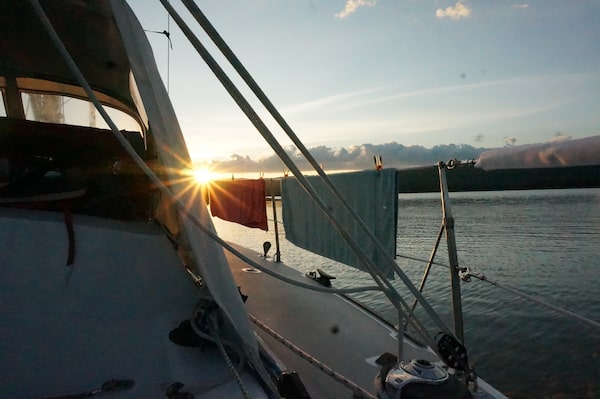
Climate change was a recurring topic of conversation for the people that Here and Now's crew met along their journey.Ian Brown/The Globe and Mail
Everywhere we went, everyone talked about climate change. A new, permanent, subconscious anxiety has infected everyone. People who live near the water talk about climate change the way octogenarians talk about their high blood pressure, easily and at random and to unknown strangers. The locals in Baddeck were convinced climate change meant less ice on Bras d’Or Lake, which meant more open salted water for the winter winds to pick up and spray on the trees, which was why there were so many patches of dead hardwood browning out the green hills each summer. The absence of ice has also meant bigger winter waves and extensive shoreline erosion. The boat that had been to Labrador with Capt. Sandy claimed to have seen 90 per cent fewer icebergs than in years past.
The water in Baddeck, on the lake, was a summery 23 degrees. The ocean off Yarmouth was 9 degrees. But in the Gulf of Maine to the east, also ocean, it bounced back to 14 and higher.
Climate change was our stowaway, the ghost crew, and there was no escaping its lurking presence. It sometimes made for an elegiac air on board.
Often, after dinner, after the spatchcocked chicken marinated in olive oil and garlic and turmeric had been dispatched, after the captain had his nightly cocktail and the boat had been tidied and stowed for the night, we talked about the future of the planet.
We sat under raking sunsets, the light racing for a last scatter against the gorgeous scudding green-grey clouds, as the gloaming rose and the moon appeared in the rigging. It was possible in that eminent light, in spite of all the dark news (Ukraine, inflation, the reversal of Roe, the revival of coal mining thanks to Putin) and the gathering storms (Hurricanes Ian and Fiona, the drought in Massachusetts and New York, the floods in Pakistan), to be … if not hopeful, at least keen to make an effort to live in such a way that we didn’t make things worse.
“Do you blame our generation, the boomers, for climate change?” I said one evening to my captain.
He didn’t answer right away.
“We screwed it up,” he finally said. “We didn’t mean to screw it up. We never do. But we always do.”
That is true of every generation. The trick is not to let yourself pretend otherwise. “Those who experience true and faithful repentance,” Melville wrote, are not “clamorous for pardon, but grateful for punishment.”
I slipped down into the hold and started the dishes. I kept thinking about Dr. Gawarkiewicz’s admiration for the adaptability of fishermen, about Owen Nichols’ faith in technology he figured would help us through the climate emergency. Their deep concern did not erase the possibility of their optimism.
That was what I liked about being on the boat: you earned your keep by doing your part and entertaining each other. You cooked meals and washed the dishes and reefed and unreefed the sails and coiled the lines while you had the chance, to be as ready as possible when the next calamity arose. You admitted to what might be coming, and kept a sharp watch.

Ian Brown/The Globe and Mail
Climate change and our oceans: More from The Globe and Mail
The Decibel podcast
Could kelp farming help the world reduce emissions from agriculture, shift away from plastics and build a green economy in coastal communities? Reporter Wendy Stueck went on a harvest off Vancouver Island to find out. Subscribe for more episodes.
More reporting
In wake of Fiona, Newfoundlanders fear the sea in communities that thrived on it for centuries
On Grand Manan, dulsers endure, despite warming ocean waters